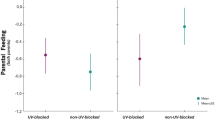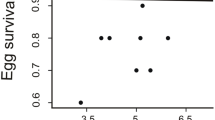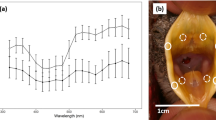Abstract
Carotenoids are integument pigments that often reflect foraging efficiency, disease resistance and body condition. In contrast to the widespread attention this relationship has received in adult birds, the condition dependence of nestling colouration remains an understudied component of animal communication. Here we assess the condition dependence of carotenoid pigmentation in nestling hihi (Notiomystis cincta, an endangered New Zealand bird) and examine the influence of carotenoid supplementation on nestling quality and parental visitation rates. Our results show that carotenoids provided to breeding adult hihi were transferred to their offspring and resulted in an intensified orange–yellow flange colour. After accounting for carotenoid supplementation the parameter that most consistently explained variation in nestling flange colour was nestling tarsus length at 23 days, indicating condition dependence of this trait. We did not, however, detect direct effects of carotenoid supplementation on nestling mass or immune response (or any other fitness parameter measured). Carotenoid supplementation did, however, result in an increased paternal provisioning rate.


Similar content being viewed by others
References
Alley MR, Castro I, Hunter JEB (1999) Aspergillosis in hihi (Notiomystis cincta) on Mokoia Island. NZ Vet J 47:88–91
Alonso-Alvarez C, Bertrand S, Devevey G, Gaillard M, Prost J, Faivre B, Sorci G (2004) An experimental test of the dose-dependent effect of carotenoids and immune activation on sexual signals and antioxidant activity. Am Nat 164:651–659
Andersson S, Prager M (2006) Quantifying colors. In: Hill GE, McGraw KJ (eds) Bird coloration. Harvard University Press, Massachusetts
Armstrong DP, Davidson RS, Dimond WJ, Perrott JK, Castro I, Ewen JG, Griffiths R, Taylor J (2002) Population dynamics of reintroduced forest birds on New Zealand islands. J Biogeog 29:609–621
de Ayala RM, Saino N, Møller AP, Anselmi C (2007) Mouth coloration of nestlings covaries with offspring quality and influences parental feeding behavior. Behav Ecol 18:526–534
Biard C, Surai PF, Møller AP (2005) Effects of carotenoid availability during laying on reproduction in the blue tit. Oecologia 144:32–44
Biard C, Surai PF, Møller AP (2006) Carotenoid availability in diet and phenotype of blue and great tit nestlings. J Exp Biol 209:1004–1015
Blount JD, Houston DC, Møller AP (2000) Why egg yolk is yellow. Trends Ecol Evol 15:47–49
Blount JD, Surai PF, Nager RG, Houston DC, Møller AP, Trewby ML, Kennedy MW (2002) Carotenoids and egg quality in the lesser black-backed gull Larus fuscus: a supplemental feeding study of maternal effects. Proc R Soc Lond B 269:29–36
Blount JD, Metcalfe NB, Birkhead T, Surai PF (2003) Carotenoid modulation of immune function and sexual attractiveness in zebra finches. Science 300:125–127
Blount JD, Houston DC, Surai PF, Møller AP (2004) Egg-laying capacity is limited by carotenoid pigment availability in wild gulls Larus fuscus. Proc R Soc Lond B 271:S79–S81
Ewen JG, Armstrong DP (2000) Male provisioning is negatively correlated with attempted extra-pair copulation frequency in the stitchbird (or hihi). Anim Behav 60:429–433
Ewen JG, Thorogood R, Karadas F, Pappas AC, Surai PF (2006a) Influences of carotenoid supplementation on the integrated antioxidant system of a free living endangered passerine, the hihi (Notiomystis cincta). Comp Biochem Physiol A 143:149–154
Ewen JG, Surai P, Stradi R, Møller AP, Vittorio B, Griffiths R, Armstrong DP (2006b) Carotenoids, colour and conservation in an endangered passerine, the hihi or stitchbird (Notiomystis cincta). Anim Cons 9:229–235
Ewen JG, Thorogood R, Nicol C, Armstrong DP, Alley M (2007) Salmonella Typhimurium in Hihi, New Zealand. J Emerg Infect Dis 13:788–790
Faivre B, Grégoire A, Préault M, Cézilly F, Sorci G (2003) Immune activation rapidly mirrored in a secondary sexual trait. Science 300:103
Fitze PS, Tschirren B (2006) No evidence for survival selection on carotenoid-based nestling coloration in great tits (Parus major). J Evol Biol 19:618–624
Fitze PS, Tschirren B, Richner H (2003) Carotenoid-based colour expression is determined early in nestling life. Oecologia 137:148–152
Götmark F, Ahlström M (1997) Parental preference for red mouth of chicks in a songbird. Proc R Soc Lond B 264:959–962
Heeb P, Schwander T, Faoro S (2003) Nestling detectability affects parental feeding preferences in a cavity-nesting bird. Anim Behav 66:637–642
Hill GE (1991) Plumage coloration is a sexually selected indicator of male quality. Nature 350:337–339
Hill GE (2006) Environmental regulation of ornamental coloration. In: Hill GE, McGraw KJ (eds) Bird coloration. Harvard University Press, Massachusetts
Hõrak P, Vellau H, Ots I, Møller AP (2000) Growth conditions affect carotenoid-based plumage coloration of great tit nestlings. Naturwissenchaften 87:460–464
Hunt S, Kilner RM, Langmore NE, Bennett TD (2003) Conspicuous, ultraviolet-rich mouth colours in begging chicks. Proc R Soc Lond B 270:S25-S28
Johnsen A, Delhey K, Andersson S, Kempenaers B (2003) Plumage colour in nestling blue tits: sexual dichromatism, condition dependence and genetic effects. Proc R Soc Lond B 270:1263–1270
Johnson JB, Omland KS (2004) Model selection in ecology and evolution. Trends Ecol Evol 19:101–108
Kilner R (1997) Mouth colour is a reliable signal of need in begging canary nestlings. Proc R Soc Lond B 264:963–968
Kilner RM (2006) Function and evolution of color in young birds. In: Hill GE, McGraw KJ (eds) Bird coloration. Harvard University Press, Massachusetts
Koutsos EA, Clifford AJ, Calvert C, Klasing KC (2003) Maternal carotenoid status modifies the incorporation of dietary carotenoids into immune tissues of growing chicks (Gallus gallus domesticus). J Nutr 133:1132–1138
Llaurado LI, Francesch A, Hernandez JM, Brafau J (1997) Effect of canthaxanthin supplementation on the hatchability of eggs of broiler breeders. In: Proceedings of 11th European Symposium on Poultry Nutrition, Faaborg, Denmark, pp 280–282
Low M, Pärt T, Forslund P (2007) Age-specific variation in reproduction is largely explained by the timing of territory establishment in the New Zealand stitchbird, Notiomystis cincta. J Anim Ecol 60:459–470
Lyon BE, Eadie JM, Hamilton LD (1994) Parental choice selects for ornamental plumage in American coot chicks. Nature 371:240–243
Magrath RD (1991) Nestling weight and juvenile survival in the blackbird, Turdus merula. J Anim Ecol 60:335–351
McGraw KJ (2006a) Mechanics of carotenoid-based coloration. In: Hill GE, McGraw KJ (eds) Bird coloration. Harvard University Press, Massachusetts
McGraw KJ (2006b) Mechanics of uncommon colors: pterins, porphyrins, and psittacofulvins. In: Hill GE, McGraw KJ (eds) Bird coloration. Harvard University Press, Massachusetts
McGraw KJ, Ardia DR (2003) Carotenoids, immunocompetence, and the information content of sexual colors: an experimental test. Am Nat 162:704–712
McGraw KJ, Adkins-Regan E, Parker RS (2005) Maternally derived carotenoid pigments affect offspring survival, sex ratio, and sexual attractiveness in a colourful songbird. Naturwissenschaften 92:375–380
Merila J, Sheldon BC, Lindstrom K (1999) Plumage brightness in relation to haematozoan infections in the greenfinch Carduelis chloris: bright males are a good bet. Ecoscience 6:12–18
Milinski M, Bakker TCM (1990) Female sticklebacks use male coloration in mate choice and hence avoid parasitized males. Nature 344:330–333
Møller AP, Christe P, Lux E (1999) Parasitism, host immune function, and sexual selection. Quart Rev Biol 74:3–20
Møller AP, Biard C, Blount JD, Houston DC, Ninni P, Saino N, Surai PF (2000) Carotenoid-dependent signals: indicators of foraging efficiency, immunocompetence or detoxification ability? Av Poul Biol R 11:137–159
Naef-Daenzer B, Widmer F, Nuber M (2001) Differential post-fledging survival of great and coal tits in relation to their condition and fledging date. J Anim Ecol 70:730–738
Olson VA, Owens IPF (1998) Costly sexual signals: are carotenoids rare, risky or required? Trends Ecol Evol 13:510–514
Perrins CM (1965) Population fluctuations and clutch size in the great tit, Parus major. J Anim Ecol 34:601–647
Perrins CM, McCleery RH (2001) The effect of fledging mass on the lives of great tits Parus major. Ardea 89:135–142
Peters A, Delhey K, Johnsen A, Kempenaers B (2007) The condition-dependent development of carotenoid-based and structural plumage in nestling blue tits: males and females differ. Am Nat 169:122–136
Potti J, Davila JA, Tella JL, Frias O, Villar S (2002) Gender and viability selection on morphology in fledgling pied flycatchers. Mol Ecol 11:1317–1326
Remeš V, Krist M, Bertacche V, Stradi R (2007) Maternal carotenoid supplementation does not affect breeding performance in the great tit (Parus major). Funct Ecol 21:776–783
Ringsby TH, Sæther B, Solberg EJ (1998) Factors affecting juvenile survival in house sparrow Passer domesticus. J Av Biol 29:241–247
Saino N, Ninni P, Calza S, Martinelli R, De Bernardi F, Møller AP (2000) Better red than dead: carotenoid-based mouth colouration reveals infection in barn swallow nestlings. Proc R Soc Lond B 267:57–61
Saino N, Ambrosini R, Martinelli R, Ninni P, Møller AP (2003a) Gape colouration reliably reflects immunocompetence of barn swallow (Hirundo rustica) nestlings. Behav Ecol 14:16–22
Saino N, Ferrari RP, Romano M, Martinelli R, Møller AP (2003b) Experimental manipulation of egg carotenoids affects immunity of barn swallow nestlings. Proc R Soc Lond B 270:2485–2489
Selvaraj RK, Koutsos EA, Calvert CC, Klasing KC (2006) Dietary lutein and fat interact to modify macrophage properties in chicks hatched from carotenoid deplete or replete eggs. J Anim Physiol Anim Nutr 90:70–80
Senar JC, Figuerola J, Pascual J (2002) Brighter yellow blue tits make better parents. Proc R Soc Lond B 269:257–261
Surai PF (2002) Natural antioxidants in avian nutrition and reproduction. Nottingham University Press, Nottingham
Thompson CW, Hillgarth N, Leu M, McClure HE (1997) High parasite load in house finches (Carpodacus mexicanus) is correlated with reduced expression of a sexually selected trait. Am Nat 149:270–294
Thorogood R, Ewen JG (2006) Rare occurrence of embryonic twins in the hihi (stitchbird) Notiomystis cincta: an endangered passerine of New Zealand. Ibis 148:828–829
Tinbergen JM, Boerlijst MC (1990) Nestling weight and survival in individual great tits (Parus major). J Anim Ecol 59:1113–1127
Tschirren B, Fitze PS, Richner H (2003) Proximate mechanisms of variation in the carotenoid-based plumage coloration of nestling great tits (Parus major). J Evol Biol 16:91–100
Tschirren B, Fitze PS, Richner H (2005) Carotenoid-based nestling coloration and parental favouritism in the great tit (Parus major). Oecologia 143:477–482
Whittingham MJ, Stephens PA, Bradbury RB, Freckleton RP (2006) Why do we still use stepwise modelling in ecology and behaviour. J Anim Ecol 75:1182–1189
Acknowledgements
We thank the New Zealand Department of Conservation and Hihi Recovery Team for supporting this work and the Supporters of Tiritiri Matangi for accommodating us on this island. Kemin kindly supplied the carotenoid supplement OroGLO and New Zealand Sugar the raw sugar base. Early discussion of this project benefited greatly from discussion with Anders Møller. This manuscript was improved by comments from Rebecca Kilner, Peter Bennett, Doug Armstrong, Chris Johnson and two anonymous referees. J. G. E. was supported by a post-doctoral research fellowship from the IoZ, with added financial support from Massey University, and a Royal Society Research Grant.
Author information
Authors and Affiliations
Corresponding author
Additional information
Communicated by Christopher Johnson.
Rights and permissions
About this article
Cite this article
Ewen, J.G., Thorogood, R., Karadas, F. et al. Condition dependence of nestling mouth colour and the effect of supplementing carotenoids on parental behaviour in the hihi (Notiomystis cincta). Oecologia 157, 361–368 (2008). https://doi.org/10.1007/s00442-008-1073-3
Received:
Accepted:
Published:
Issue Date:
DOI: https://doi.org/10.1007/s00442-008-1073-3




